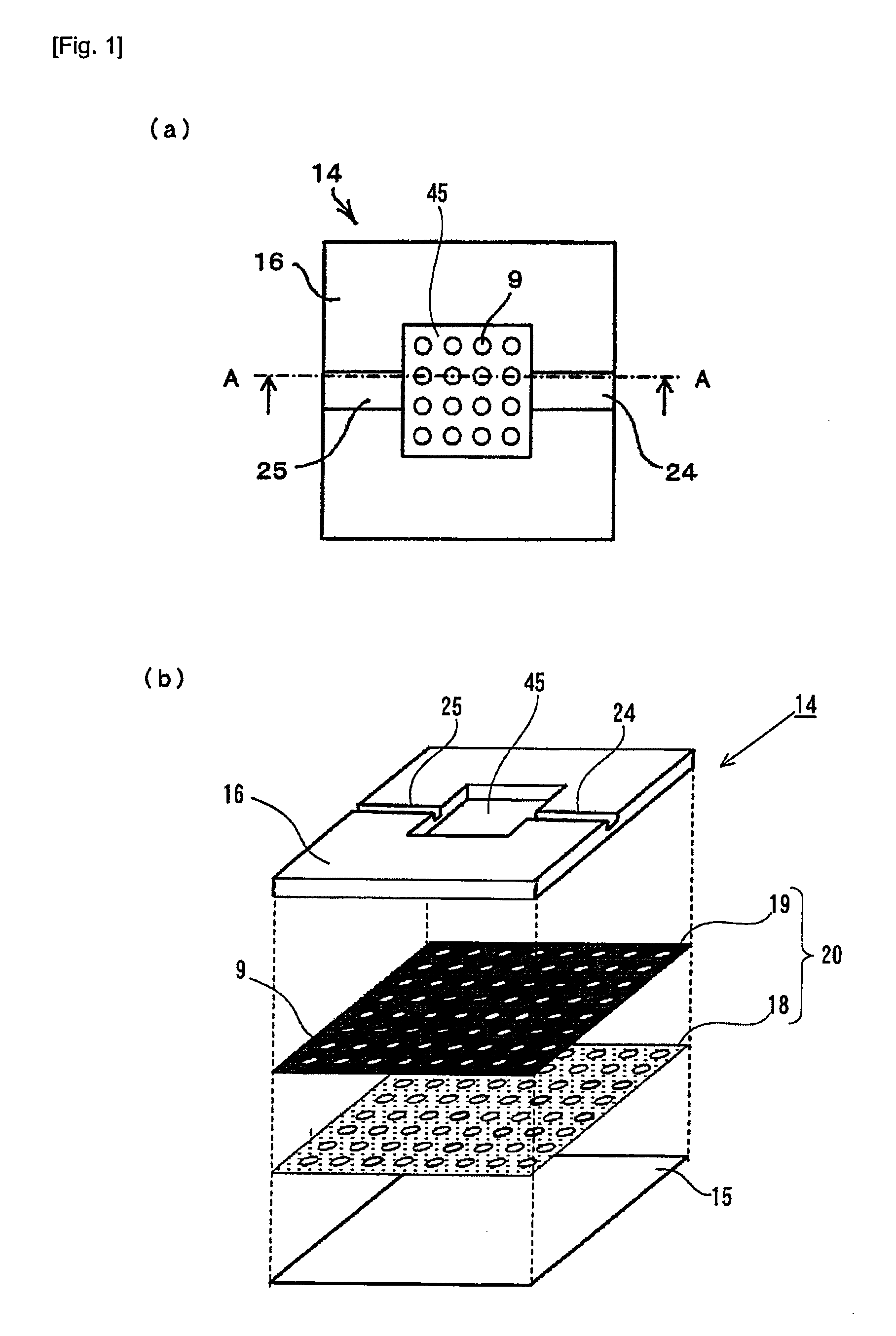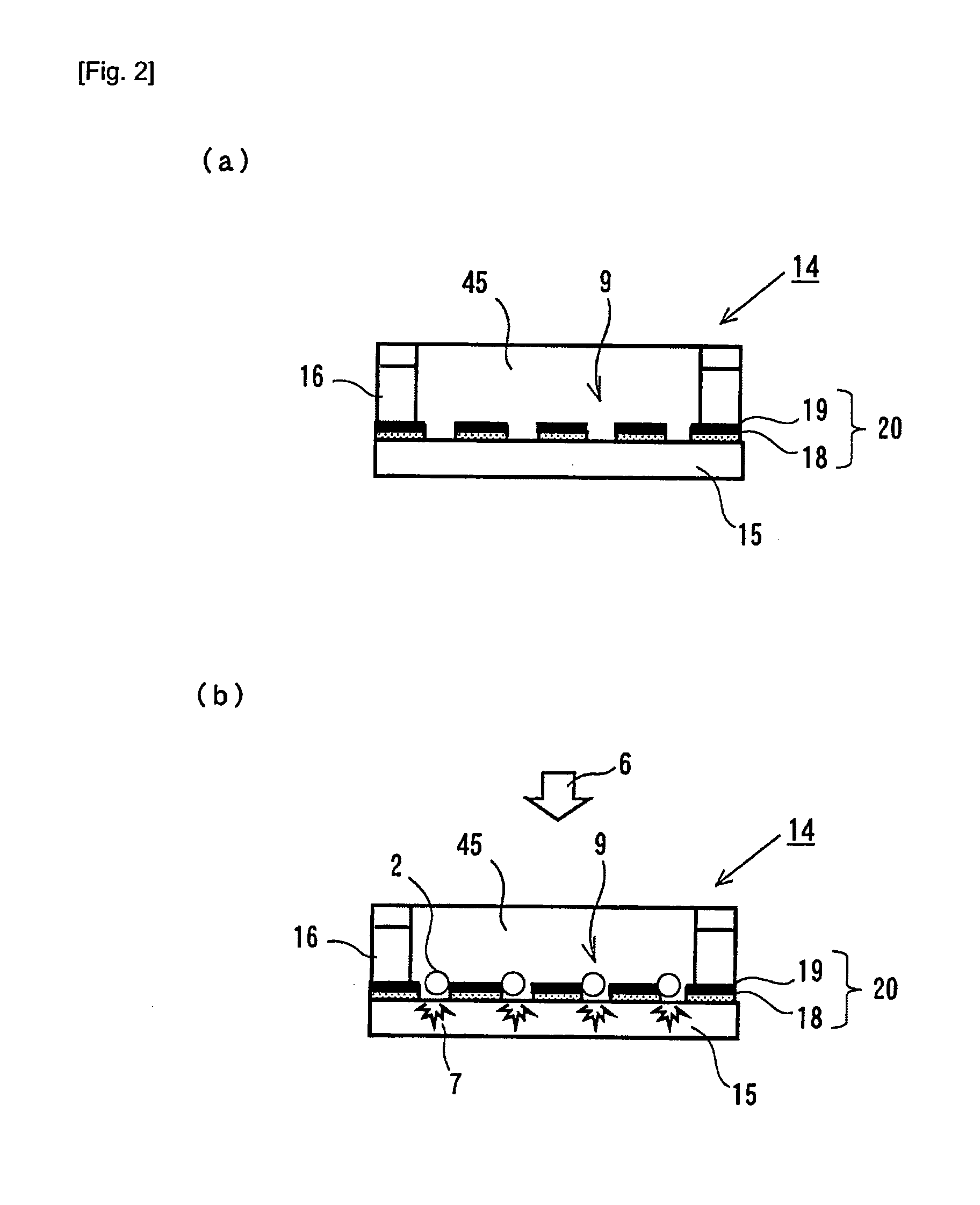Structure for particle immobilization and apparatus for particle analysis
a technology of structure and particle, which is applied in the direction of material analysis, photoelectric discharge tubes, instruments, etc., can solve the problems of reducing the detection accuracy and the detection accuracy of fluorescence signal intensity, so as to reduce background noise, crosstalk noise or the like
- Summary
- Abstract
- Description
- Claims
- Application Information
AI Technical Summary
Benefits of technology
Problems solved by technology
Method used
Image
Examples
first embodiment
[0089]FIGS. 1 and 2 schematically show the structure according to the first embodiment. FIG. 1(a) shows a plan view of the structure, and FIG. 1(b) shows an exploded perspective view to illustrate the layer structure of the structure. FIG. 2(a) shows a sectional view of in FIG. 1(a) along with A-A, and FIG. 2(b) shows a state where biological samples (for example, cells) are immobilized to the structure.
[0090]As shown in FIGS. 1 and 2, the structure 14 is composed of a flat plate substrate 15, a holding unit 20 which is arranged on the substrate 15, and a spacer 16 for forming, above the holding unit 20, a space (referred to as “accommodating unit” as well) 45 for introducing thereinto a suspension containing the biological sample. The holding unit 20 is composed of a stack of an insulator film 18 and a light shielding film 19. The light shielding film 19 is arranged above the insulator film 18. The holding unit 20 has a plurality of holding holes (through-holes) 9 which are formed ...
second embodiment
[0093]FIGS. 3 and 4 schematically show the configuration of the structure and the particle immobilizing apparatus according to the second embodiment. FIG. 3 shows an exploded perspective view to illustrate the layer structure of the structure, and FIG. 4 shows a sectional view of the structure. FIG. 4 shows a cross section of the same portion as that corresponding to the A-A line shown in FIG. 1(a) (the same hold for sectional views described later on). The structure 14 of the second embodiment has a comb-shaped electrode 21 which is composed of a pair of electrodes 22 and 23 on the holding unit-side surface of the substrate 15. Each of the electrodes 22 and 23 has a plurality of band-shaped electrodes which are arranged in parallel to one another in the direction of arrangement of the holding holes 9. The band-shaped electrodes of one electrode 22 and the band-shaped electrodes of the other electrode 23 are arranged alternately to one another. As shown in FIG. 4, the band-shaped el...
third embodiment
[0094]FIG. 5 shows the structure and the particle immobilizing apparatus according to the third embodiment. The difference from the structure of the second embodiment shown in FIG. 4 resides in that an upper lid 17 which covers the accommodating unit 45 is provided on the spacer 16. The provision of the upper lid 17 is advantageous in that the water content of the suspension containing the biological sample introduced into the accommodating unit 45 can be prevented from being evaporated and the suspension containing the biological sample can be stably supplied from the introducing port 24 into the accommodating unit 45. The reason why the supply of the suspension is stabilized is considered to be because the flow line of a fluid which flows between the upper lid 17 and the accommodating unit 45 of the spacer 16 easily forms a laminar flow parallel to the plane of the substrate. The upper lid can also be provided for the structure of the first embodiment in order to obtain a similar ...
PUM
| Property | Measurement | Unit |
|---|---|---|
| thickness | aaaaa | aaaaa |
| thickness | aaaaa | aaaaa |
| contact angle | aaaaa | aaaaa |
Abstract
Description
Claims
Application Information
 Login to View More
Login to View More - R&D
- Intellectual Property
- Life Sciences
- Materials
- Tech Scout
- Unparalleled Data Quality
- Higher Quality Content
- 60% Fewer Hallucinations
Browse by: Latest US Patents, China's latest patents, Technical Efficacy Thesaurus, Application Domain, Technology Topic, Popular Technical Reports.
© 2025 PatSnap. All rights reserved.Legal|Privacy policy|Modern Slavery Act Transparency Statement|Sitemap|About US| Contact US: help@patsnap.com



